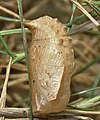| Calisto herophile | |
|---|---|
 | |
| In Cuba | |
| Scientific classification | |
| Domain: | Eukaryota |
| Kingdom: | Animalia |
| Phylum: | Arthropoda |
| Class: | Insecta |
| Order: | Lepidoptera |
| Family: | Nymphalidae |
| Genus: | Calisto |
| Species: | C. herophile |
| Binomial name | |
| Calisto herophile Hübner, 1823 | |
| Synonyms | |
| |
Calisto herophile is a butterfly of the family Nymphalidae. It is endemic to Cuba [1] and the Bahamas. The species inhabits many habitats in Cuba, from suburban areas near major cities to the edges of evergreen and rainforests up to 1,100 meters of altitude, always disturbed in some degree.
Contents
The length of the forewings is 14–19 mm for males and 17–21 mm for females. [2] Adults are found year-round throughout Cuba.
The larvae feed on various grasses. [3]









